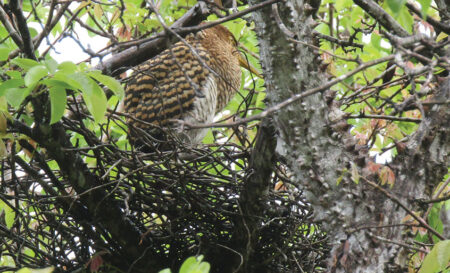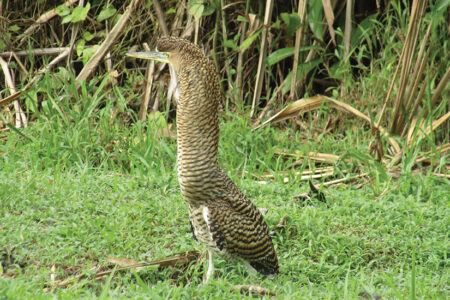THE SAGA OF BABY HUEY THE BARE-THROATED TIGER HERON
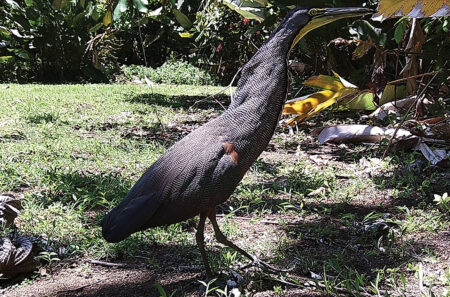
For those of you who are too young to have known the cartoon character “Baby Huey”, he was an overgrown duckling created by Martin Taras for Paramount Pictures Famous Studios and was in vogue when I was growing up during the 1950s. Currently, Diane and I have the good fortune to live where we see Bare-throated Tiger Herons every day and nests every year. As you may have guessed from the title, one of the chicks turned out to be exceptionally large thus earning itself the nickname “Baby Huey”.
The species doesn’t mate at any particular time of year, but we know it’s time be on the lookout for tiger herons carrying thin sticks for nest building and pay close attention to which tree they take them to when we start hearing the loud, booming courtship roar of the male in the early morning and late evening. After seeing my first bare-throated tiger heron I surmised that the name “Tiger Heron” came about because of the stripes, but once I heard the roar, the source of the name became obvious.
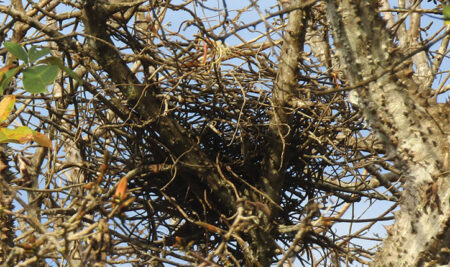
Every year a nest that is visible from our front porch appears in the upper branches of a spiny cedar tree located at the edge of our yard. As the name suggests, the trunk and branches of the spiny cedars are adorned with tough, thick, sharp thorns which hamper me from climbing up and peering into the nest to see what the eggs look like. Apparently, someone did climb a nest bearing tree that didn’t have spines and had a look because A Guide to the Birds of Costa Rica, by Stiles and Skutch, describes them as dull white tinged with green. It also says there are two or three eggs per nest. The nests we have had the good fortune to observe have both produced only one chick, but they could have started out with more than one egg.
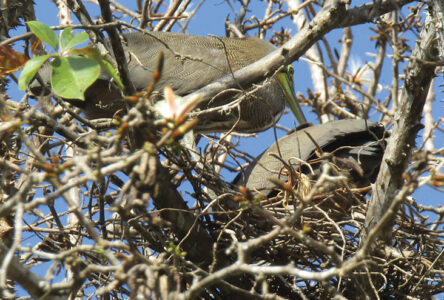
I’m not well enough organized to keep track of all the dates beginning with the building of the nest and ending with the fledging of the chick. But when I started selecting photos for this article, I realized that my digital camera had done that for me. Spiny cedars lose all their leaves at the start of the dry season, and the crown was open, the nest was clearly visible, and it was easy to get good photos every day. January 30 was the first time we saw the parents sitting on the nest, more than likely incubating the egg or eggs. That time of year we have lots of sun and little rain, and the parent who had charge of the egg overnight left the nest every morning about 9:00 and let the sun do the incubating. One of them would return around 4:00 pm and stay all night. We never saw hide nor hair of the adults during the day. Our first sighting of Baby Huey was the last day of March after two months of incubation. However, at that time he looked more like a white, fluffy version of “Angry Bird” than of an overgrown anything. He gradually lost the fluff and acquired the plumage of an immature tiger heron.
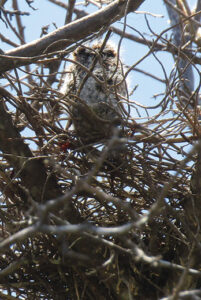
As the chick grew, we learned what the parents had been doing during the day, chowing down on fish, frogs, snails, worms, crabs, insects, and even snakes. Then around 4:00 pm, when they returned to the nest, they regurgitated all those partially digested goodies into the chick’s wide-open mouth. This went on and on and on for nearly a month. It was during this period that Baby Huey acquired his name because he just kept growing and growing and growing, and we were wondering if he was ever going to leave the nest. I guess he was one of those kids who wanted to live at home and eat mom and dad’s food forever. And mom and dad seemed okay with that. It was late June when Huey finally made the big move and left the nest, but not completely. Believe it or not, after poking around in mud puddles all day, he returned to the nest every evening to be fed, slept in his own “bed”, and left after being fed the next morning. As of this writing, Baby Huey has finally cut the apron strings and is dealing with life on his own. Way to go buddy. We knew you had it in you, and we’re proud of you.
